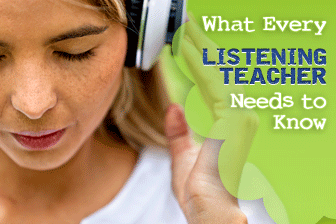What Every Listening Teacher Needs to Know


It can sometimes be difficult or frustrating coming up with natural ways for students to practice listening and sharpen it.
We have come up with the three most successful approaches we’ve found for creating all-around better listening skills.
This is my all-time favorite tip for teaching better all-around listening. If you can find topics the students are really interested in—fashion, politics, music- then you can tap into a whole world out there of people speaking, singing, explaining, and discussing. I often used NPR in my classes, but also found that children’s movies were a terrific resource as were some of the best bands of all time like the Beatles or the Rolling Stones. Supplemental programs like Rosetta Stone are also excellent starting points for additional listening exercises. Students are interested in fun, real-life ways to hear and process language. You can use fill-in-the-blank song lyrics to teach tenses or other grammatical points while enhancing listening skills. You can find all kinds of videos online that show people in different circumstances, speaking more slowly than in TV or movies. Use the resources out there and get creative. Students will liven up when you bring music or movie clips into the classroom. It gives them a break from listening to you and their classmates and they can experience different accents, slang, real speed language, just to name a few.
Something you can do regularly is to bring guest speakers into your class. Have them present on a topic relevant to the class and make sure students are prepared for this in advance. Have each student ask at least two questions, and then do group activities following the visit such as paraphrasing, reporting speech, or simply discussing the speaker as well as the topic. This is another way for the students to get exposure to listening to someone other than their classmates all the time. The more interaction they can have with the speaker, the better. Sometimes students clam up in these situations, so be sure to have some motivating reasons for them to actively participate.
A certain amount of translation is okay depending on the class and what is being translated. What I mean here is to definitely get students away from the habit of first listening to English and then translating it into their language and then back into English again. It is too time consuming, and will only lead them to frustration and confusion. Generally this is allowed for real beginners, but after they have learned an arsenal of words, they must begin listening and really hearing the language to comprehend it. You will notice that most student notebooks are littered with translations. That is fine as long as it leads them to understanding. Often they are using the translations for literal pronunciations in their language at first and then gradually will begin to write more and more purely in English. When they are listening, try to curb others from translating for them or for them to constantly consult electronic dictionaries. It takes practice to get used to anticipating what they are going to hear so that they can respond. Encourage them in every way you can to think in English for that hour or two a day.
Students may struggle at first, but that is part of the process. Once they can begin really hearing the language they are learning, they will be able to function much more independently.